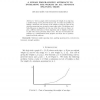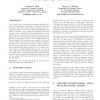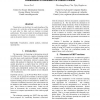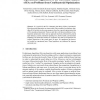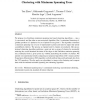NETWORKS
2008
14 years 4 months ago
2008
Given a graph where increasing the weight of an edge has a nondecreasing convex piecewise linear cost, we study the problem of finding a minimum cost increase of the weights so tha...
DEXA
2010
Springer
14 years 4 months ago
2010
Springer
Given a spatio-temporal network (ST network) whose edge properties vary with time, a time-sub-interval minimum spanning tree (TSMST) is a collection of distinct minimum spanning t...
SODA
2004
ACM
14 years 6 months ago
2004
ACM
We consider the problem of finding a sparse set of edges containing the minimum spanning tree (MST) of a random subgraph of G with high probability. The two random models that we ...
SAC
2000
ACM
14 years 9 months ago
2000
ACM
The coding by which chromosomes represent candidate solutions is a fundamental design choice in a genetic algorithm. This paper describes a novel coding of spanning trees in a gen...
IV
2002
IEEE
14 years 9 months ago
2002
IEEE
Visualization can facilitate the understanding of the structures of a collection of documents that are related to each other by links, such as citations in formal publications. We...
PPSN
2004
Springer
14 years 10 months ago
2004
Springer
It is typical for the EA community that theory follows experiments. Most theoretical approaches use some model of the considered evolutionary algorithm (EA) but there is also some ...
IFIP
2004
Springer
14 years 10 months ago
2004
Springer
We develop an external memory algorithm for computing minimum spanning trees. The algorithm is considerably simpler than previously known external memory algorithms for this proble...
GECCO
2004
Springer
14 years 10 months ago
2004
Springer
Randomized search heuristics, among them randomized local search and evolutionary algorithms, are applied to problems whose structure is not well understood, as well as to problems...
ICTAI
2006
IEEE
14 years 10 months ago
2006
IEEE
We propose two Euclidean minimum spanning tree based clustering algorithms — one a k-constrained, and the other an unconstrained algorithm. Our k-constrained clustering algorith...
